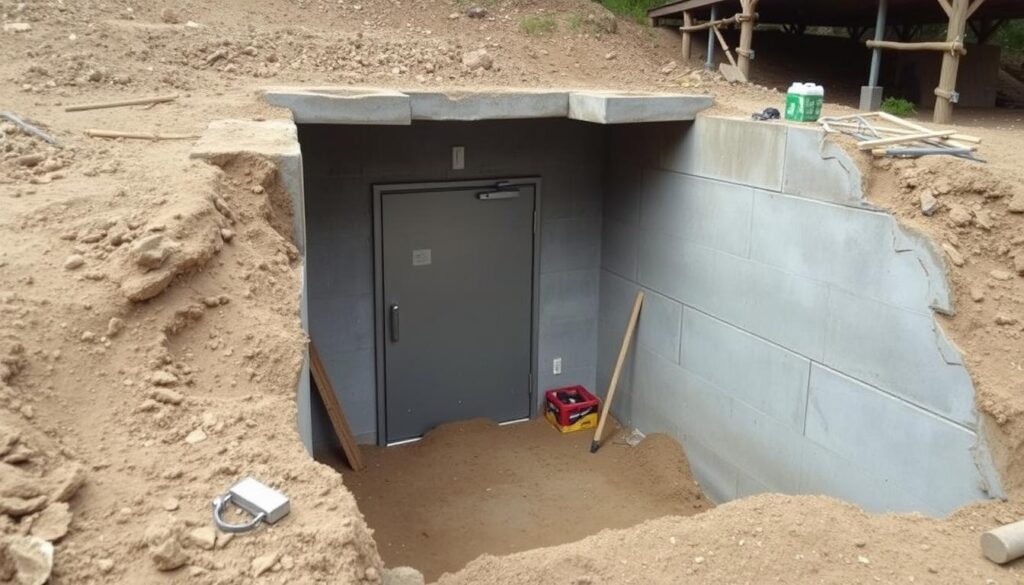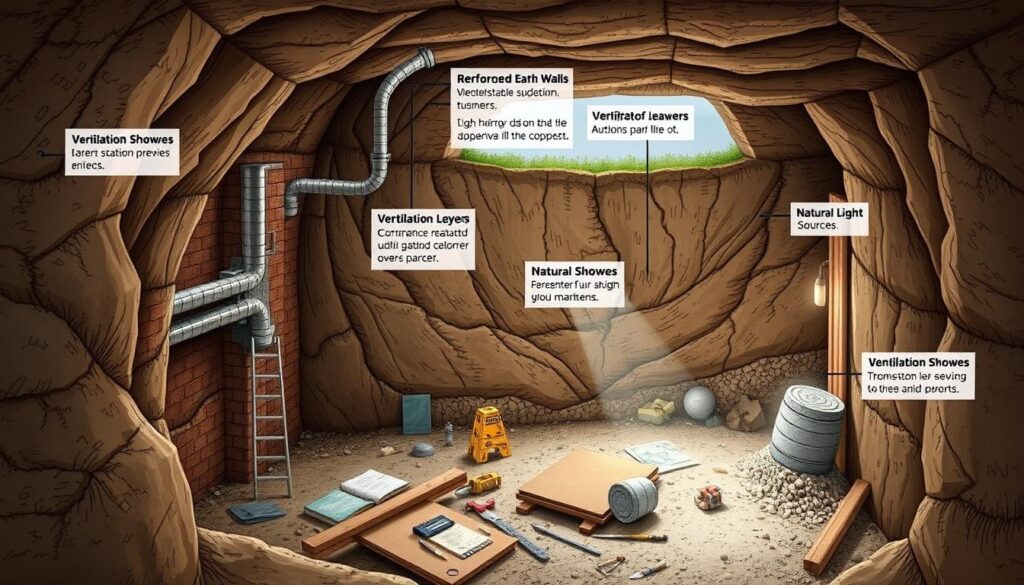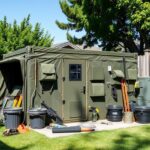Thinking about building an underground shelter? You’re probably looking for safety and protection. With the right techniques, you can make a secure place. DIY bunkers cost around $1,0001, while luxury ones can be $35,000 to $14 million1.
When building a shelter, think about the soil, water, and how easy it is to get to. Choose a dry spot with gravel soil. Avoid places with gas or shallow water. A good size for a shelter is 3 feet wide, 5 feet deep, and 11 feet long for 4 people1.
Key Takeaways
- Building an underground shelter needs careful planning and thinking about soil and access.
- The cost for a DIY bunker is about $1,0001.
- Luxury bunkers cost between $35,000 and $14 million1, showing a big price difference.
- Shipping containers cost between $3,000 to $5,000 USD2.
- 36 inches of soil can reduce gamma radiation by 95%1.
- Each person needs about 1 gallon of water per day in the shelter1.
The Most Comprehensive And Up To Date Construction Guide Available
Understanding Underground Shelter Basics
Building an underground shelter requires knowing the basics. This includes subterranean survival shelter design and diy underground bunker construction. Each person needs about 20 square feet for basic living3. Shelters should be 10 to 12 feet wide, 16 to 20 feet long, and 8 to 10 feet high3.
A good shelter needs a reliable water source. Store at least one gallon of water per person per day. This should last for two weeks3. Building a simple shelter can cost between $10,000 to $50,0003. Popular types include pole-covered trenches and earthbag structures2.
Here are some key things to consider when building an underground shelter:
- Soil stability analysis to find the best location3
- Choosing the right materials, like concrete, steel, or earthbags2
- Good ventilation and air filters for a healthy environment3
By knowing these basics, you can build a safe and useful underground shelter. It will be a secure place in times of crisis.
| Shelter Type | Cost | Space Requirements |
|---|---|---|
| Pole-covered trench shelter | $3,000 to $5,000 | 10 to 12 feet wide, 16 to 20 feet long |
| Earthbag structure | $10,000 to $50,000 | 20 to 30 feet wide, 30 to 40 feet long |
Essential Planning and Legal Requirements
Building a hidden shelter below ground requires careful planning. You must follow local laws and building codes4. It’s important to know your goals and pick the right spot. Consider the soil, water, and how easy it is to get there.
Earth-sheltered homes might cost more but need less upkeep4.
Planning is key for storm shelters. A 90-day bunker needs space for everyone and supplies5. Nuclear shelters need extra protection5.
When building an underground shelter, think about:
- Soil type and drainage
- Water table assessment
- Accessibility and emergency escape routes
Before starting, learn about local laws and codes. About 70% of DIY bunker builders used online guides5.

Follow storm shelter tips and plan well. This way, you can create a safe underground shelter4.
Site Selection and Soil Analysis
Choosing the right site is key when building an underground retreat. You need to check the soil and rock types at the site6. Also, knowing the water table level is important for picking a good spot7.
It’s also vital to pick a spot that’s easy to get to and has stable soil. This ensures your underground shelter is safe and stable. The right location makes your bunker building work better and faster.
When picking a site, think about how close it is to water, the soil type, and how easy it is to get to. You should also check the water table level to avoid flooding. By looking at these factors, you can build a safe and secure underground retreat.
Soil analysis is also important for building an underground retreat. You need to check the soil’s type, density, and more to see if it’s good for underground work6. A detailed soil analysis helps make sure your bunker is safe and well-built.
Underground Shelter Construction Techniques
Building an underground shelter requires careful planning. You need to choose the right excavation methods, like digging a hole and making the soil stable8. It’s also important to use strong materials, like reinforced concrete, to keep the structure stable and strong8.
A good underground shelter should have enough space for everyone. It should have at least 20 square feet of living space per person8. You also need a reliable water system, with enough water for each person for two weeks8.
Excavation Methods
Excavation uses tools like excavators and dump trucks to make the process faster8. It’s also important to keep everyone safe during this time. This includes using safety gear and making sure the structure is supported8.
Structural Support Systems
Structural support systems, like steel beams and concrete, are key for stability8. Adding rebar to the concrete is also important for the structure’s strength8.
Waterproofing Solutions
The Most Comprehensive And Up To Date Construction Guide Available
Waterproofing is vital to keep the shelter dry and safe9. You can use waterproof materials and a good drainage system to prevent water damage9.

| Construction Technique | Description |
|---|---|
| Excavation Methods | Use of excavators and dump trucks to speed up the process |
| Structural Support Systems | Use of steel beams and concrete to ensure stability and durability |
| Waterproofing Solutions | Use of waterproof materials and implementation of a reliable drainage system |
By using these techniques, you can build a safe underground shelter8. It’s also wise to get expert advice and follow local building rules to make sure your shelter is top-notch10.
Ventilation and Air Filtration Systems
In subterranean survival shelter design, air systems are key for safety and health. A steady air supply is vital, and air pollution risks must be lessened. High-Efficiency Particulate Air (HEPA) filters can catch over 99.97% of tiny particles, making them essential for diy underground bunker construction11.
A good ventilation system needs air intake and exhaust fans for air exchange. This is critical in underground shelters, where air can quickly become stale and polluted. Without proper ventilation, people in such shelters can suffer from heat collapse in warm weather12.
Keeping air quality high means maintaining humidity levels between 30% and 50%. Advanced sensors can adjust HVAC systems to keep humidity in check11. Also, a steady flow of fresh air is needed to keep oxygen levels up and prevent carbon dioxide buildup11.
Important aspects of ventilation and air filtration systems include:
* Using military-grade filters to remove harmful gases and pollutants
* Keeping temperatures stable to avoid extreme changes
* Choosing energy-efficient HVAC systems to save power
* Having backup power to keep systems running during outages
* Designing for enough fresh air to remove body heat and prevent carbon dioxide buildup12.
By focusing on these aspects in subterranean survival shelter design, people can create safe, healthy spaces. Whether it’s a diy underground bunker or a commercial shelter, air systems are critical and should not be ignored.
| System Component | Description |
|---|---|
| Air Intake Fans | Draw in fresh air from outside the shelter |
| Exhaust Fans | Remove stale air from the shelter |
| HEPA Filters | Capture 99.97% of particles as small as 0.3 microns |
| Advanced Sensors | Automatically adjust HVAC system operations based on detected humidity levels |
Essential Utility Installation
Building a hidden shelter below ground needs careful planning for utilities. This includes electrical systems, water supply, and communication. A typical underground shelter should have at least 20 square feet per person for basic needs. It should be 10 to 12 feet wide, 16 to 20 feet long, and 8 to 10 feet high13.
For a safe storm shelter, reliable electrical systems are key. This includes generators and batteries13. It’s also important to have enough water, with one gallon per person per day for two weeks13. In places like the Panhandle of Florida, the water table is close to the surface14.
Some important things to think about for utility installation are:
- Electrical systems: generators, batteries, and solar panels
- Water supply: storage capacity, water purification systems, and plumbing
- Communication infrastructure: radios, phones, and internet connectivity
By following these tips, you can build a safe and cozy underground shelter13.
Entry and Exit Design Considerations
When building a fortified underground shelter, the entry and exit design is key. It affects the shelter’s safety and usefulness. A good design ensures a safe way in and out, protecting against dangers15. says an underground shelter must have an emergency exit for safety.
Planning and detail are vital for a good entry and exit system. Choose a location that’s stable and close to home16. The shelter’s size, including width, length, and height, must fit everyone and supplies15.
Some important things to think about include:
The Most Comprehensive And Up To Date Construction Guide Available
- Concealment techniques, like camouflage and smart door and lock placement16
- Emergency escape routes, with backup exits in case of blockage15
- Soil tests to check the soil’s strength and prevent cave-ins16
By focusing on these points, you can build a safe underground shelter. Remember, when using secret bunker building techniques, don’t overlook entry and exit design15.
Interior Layout and Storage Solutions
Building an underground shelter requires careful planning. Underground shelter construction techniques are key to making the space useful and cozy. A good size for a shelter is at least 20 square feet per person, with typical sizes ranging from 10 to 12 feet wide, 16 to 20 feet long, and 8 to 10 feet high3.
Efficient storage is vital to keep the space tidy. You’ll need shelving and cabinets for food, water, medical supplies, and more. These can be part of your underground bunker building methods3.
A well-thought-out layout is essential for a comfortable shelter. Use bunk beds, desks, and other furniture to make the space functional. Also, consider using reinforced concrete walls and proper ventilation systems for safety and security3.
Here are some tips for storage solutions:
- Water storage: aim for one gallon of water per person per day, with a minimum of a two-week supply per individual3
- Food supply: store enough non-perishable items to last at least two weeks, such as canned goods and freeze-dried meals3
- Medical supplies: include items such as band-aids, antiseptics, and over-the-counter medications, with a focus on essential personal prescriptions3
By using these storage solutions and underground bunker building methods, you can build a safe and cozy shelter. This will help you in emergencies.
Always follow proper underground shelter construction techniques and building methods. This ensures your shelter stays safe and secure3.
Safety Features and Emergency Protocols
When building a subterranean survival shelter, safety is key. A good diy underground bunker should have fire prevention, emergency supplies, and security. The U.S. sees about 1,000 tornadoes a year, making a safe underground shelter vital17.
Fire prevention is a must. Use fire alarms, smoke detectors, and extinguishers. Regular checks keep these systems working right. Also, having emergency supplies like food, water, and medical items is essential18.
Security is also important. This includes cameras, alarms, and other systems to keep the shelter safe. Good ventilation is also key, with designs that use turbine vents to keep air moving17. These features help make a safe and secure underground bunker.
Here are some key considerations for safety features and emergency protocols:
- Fire prevention systems, including fire alarms and smoke detectors
- Emergency supply storage, including food, water, and medical supplies
- Security measures, such as security cameras and alarms
- Proper ventilation, including turbine vents to reduce humidity and ensure air circulation
By following these guidelines, you can build a safe and secure underground bunker. It will protect you and your loved ones in emergencies17.
| Safety Feature | Description |
|---|---|
| Fire Prevention | Fire alarms, smoke detectors, and fire extinguishers |
| Emergency Supply Storage | Reliable source of food, water, and medical supplies |
| Security Measures | Security cameras, alarms, and other systems |
Conclusion: Ensuring Long-Term Shelter Sustainability
When building your own underground shelter, focus on making it last19. These shelters protect against natural disasters, which harm nearly 65 million people worldwide each year19. In the U.S., about 14% of people live in hurricane zones, and over 1,000 tornadoes hit each year19.
Keeping your shelter in good shape is key20. For long-term shelters, regular checks are vital to keep everything working right20. This means checking the structure, fixing leaks, and restocking supplies as needed19.
Also, adding green features like solar power and food systems makes your shelter more self-sufficient20. A debris hut needs at least 2 feet of insulation, but 3-4 feet is better in cold areas20. By planning ahead and using these tips, your shelter will be safe and ready for emergencies.
FAQ
What are the different types of underground shelters?
What are the primary functions and benefits of underground shelters?
What are the common construction materials used in underground shelters?
What are the essential planning and legal requirements for building an underground shelter?
What are the key factors to consider when selecting a site for an underground shelter?
What are the essential construction techniques for building an underground shelter?
Why is ventilation and air filtration important in underground shelters?
What are the key utility installation considerations for an underground shelter?
How should the entry and exit of an underground shelter be designed?
What are the important safety features and emergency protocols for an underground shelter?
Source Links
- How to build a cheap DIY underground bunker to protect you from nuclear fallout, in 6 steps – https://www.businessinsider.com/cheap-diy-underground-bunker-fallout-shelter-2023-5
- How to Build an Underground Bunker (with Pictures) – wikiHow – https://www.wikihow.com/Build-an-Underground-Bunker
- How To Build An Underground Shelter: A Comprehensive Guide – https://www.battlbox.com/blogs/outdoors/how-to-build-an-underground-shelter-a-comprehensive-guide?srsltid=AfmBOoo3HsaayjCf0YqjgF4t6CKHB0Lv4gYsMQJHq2QHKQOKCHaOj47K
- Efficient Earth-Sheltered Homes – https://www.energy.gov/energysaver/efficient-earth-sheltered-homes
- How to Build Your Own Underground Bunker – https://offgridsurvival.com/how-to-build-your-own-underground-bunker/
- How To Build a Storm Shelter – https://www.thisoldhouse.com/sheds/21016721/how-to-build-a-storm-shelter
- The Ultimate Guide to Survival Shelters for Emergencies – https://www.mirasafety.com/blogs/news/your-key-to-wilderness-safety?srsltid=AfmBOorjsHtmigZ0IG3ESDlQ1WDu8ov5eCLVZpFicQgnTboZENXS7iZK
- How To Build An Underground Shelter: A Comprehensive Guide – https://www.battlbox.com/blogs/outdoors/how-to-build-an-underground-shelter-a-comprehensive-guide?srsltid=AfmBOorJAoQjnIEkI5lHmc70DniO0n6SXOzrnNo7uoCrFWRDKbsTStnb
- Building a Shelter After an Emergency: Essential Steps, Survival Tools, and Detailed Techniques – https://www.survivalcavefood.com/blog/building-a-shelter/?srsltid=AfmBOorKJZLhLP33Jni_2cBXIjl52L8JVXEoEi3YtJMYSrbl8NqXVNQp
- How to Build an Underground Bunker – https://thereadystore.com/blogs/news/how-to-build-an-underground-bunker?srsltid=AfmBOordSqmttrNB-ue7wN9vOTft-jZkve5Xv9xM24pXGAh_FcONFlGj
- How HVAC Systems Manage Air Quality in Underground Bunkers – https://www.acdirect.com/blog/hvac-systems-air-quality-underground-bunkers/?srsltid=AfmBOoq5DYbiANeFh0rGrvtzEDngf2HkERf1sh93YKxYGeZ_wwgQew_0
- Ch. 6: Ventilation and Cooling of Shelters – https://www.oism.org/nwss/s73p917.htm
- How To Build An Underground Shelter: A Comprehensive Guide – https://www.battlbox.com/blogs/outdoors/how-to-build-an-underground-shelter-a-comprehensive-guide?srsltid=AfmBOoqzMvimxNyw9odKq57SvEMHUVGl23cF4xjNtsIBv1UW894b6LJn
- How to Build a Super Top Secret Bunker Under Your House. the Prelude… – https://www.instructables.com/How-to-Build-a-Super-Top-Secret-Bunker-under-Your-/
- How To Build An Underground Shelter: A Comprehensive Guide – https://www.battlbox.com/blogs/outdoors/how-to-build-an-underground-shelter-a-comprehensive-guide?srsltid=AfmBOoqr0nTHIeacCjFGcSuQOsotTyVaUIkOQpLOtH90wWDnyGgLb-hu
- Tips for Building a Bomb Shelter | R.J. Potteiger, Inc. – https://www.rjpotteigerinc.com/blog/tips-for-building-a-bomb-shelter/
- Comprehensive Guide to Underground Tornado Shelters – https://www.battlbox.com/blogs/outdoors/comprehensive-guide-to-underground-tornado-shelters?srsltid=AfmBOop3kqdVEudnt9wCNXYx5pnynaC182ClEfxzS4Qg3_ZnD2yWkgEf
- The Ultimate Guide to Survival Shelters for Emergencies – https://www.mirasafety.com/blogs/news/your-key-to-wilderness-safety?srsltid=AfmBOoqesBI9L0hbESdNc3YSkDklH9jsN4nZ-yVZUn4sE3ep7HwoOsWM
- How To Build An Underground Shelter: A Comprehensive Guide – https://www.battlbox.com/blogs/outdoors/how-to-build-an-underground-shelter-a-comprehensive-guide?srsltid=AfmBOoon8SrfLwlkbi2eT5lHnnNCwMFdfHBpcvl3ufu0_VJCBDTzWMEI
- The Ultimate Guide to Survival Shelters for Emergencies – https://www.mirasafety.com/blogs/news/your-key-to-wilderness-safety?srsltid=AfmBOoqxmDVA3ZEbtzjx9yWQ_uO6wQ1K2dQoeMgGm9NGmeDbjJS7uTDj



Pingback: Budget-Friendly Bunker Kits to Protect Your Home
Pingback: Mastering Long-Term Food Storage: Ensuring Sustenance in Your Bunker